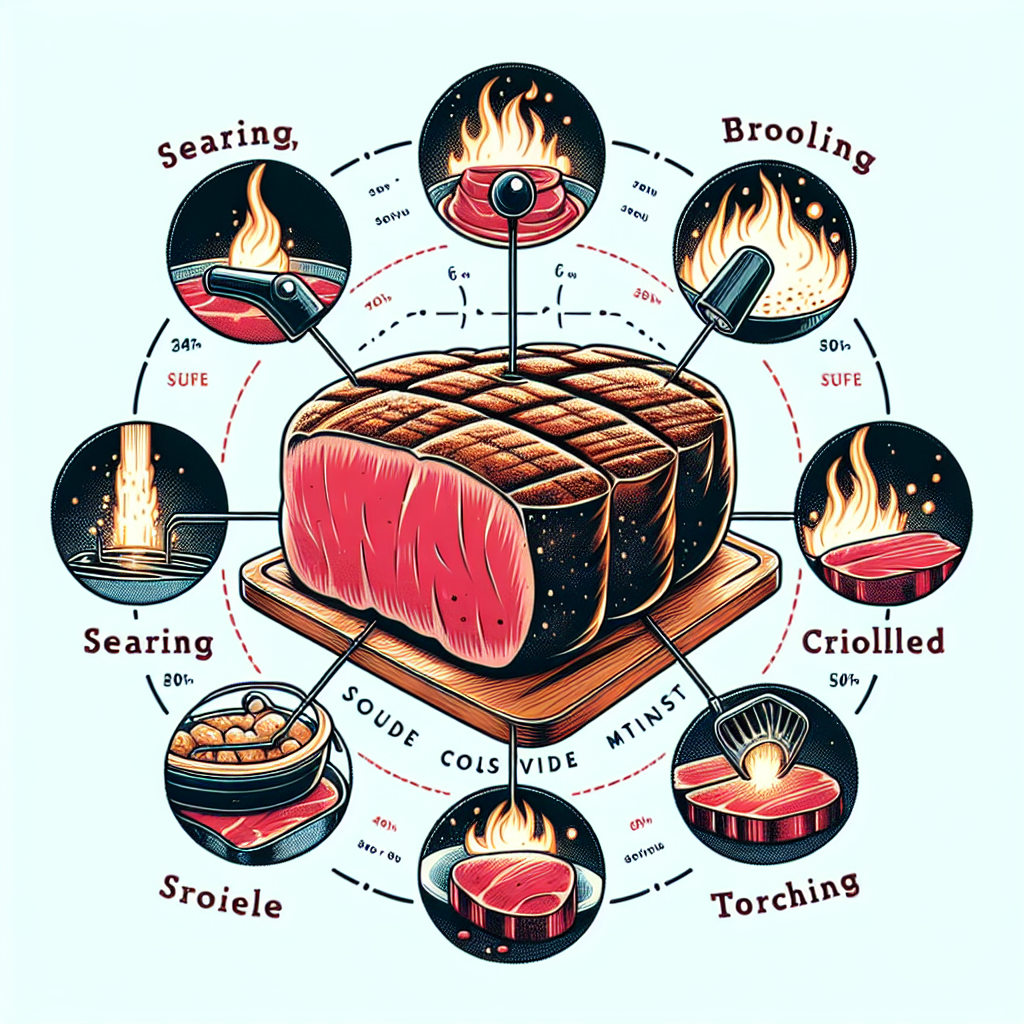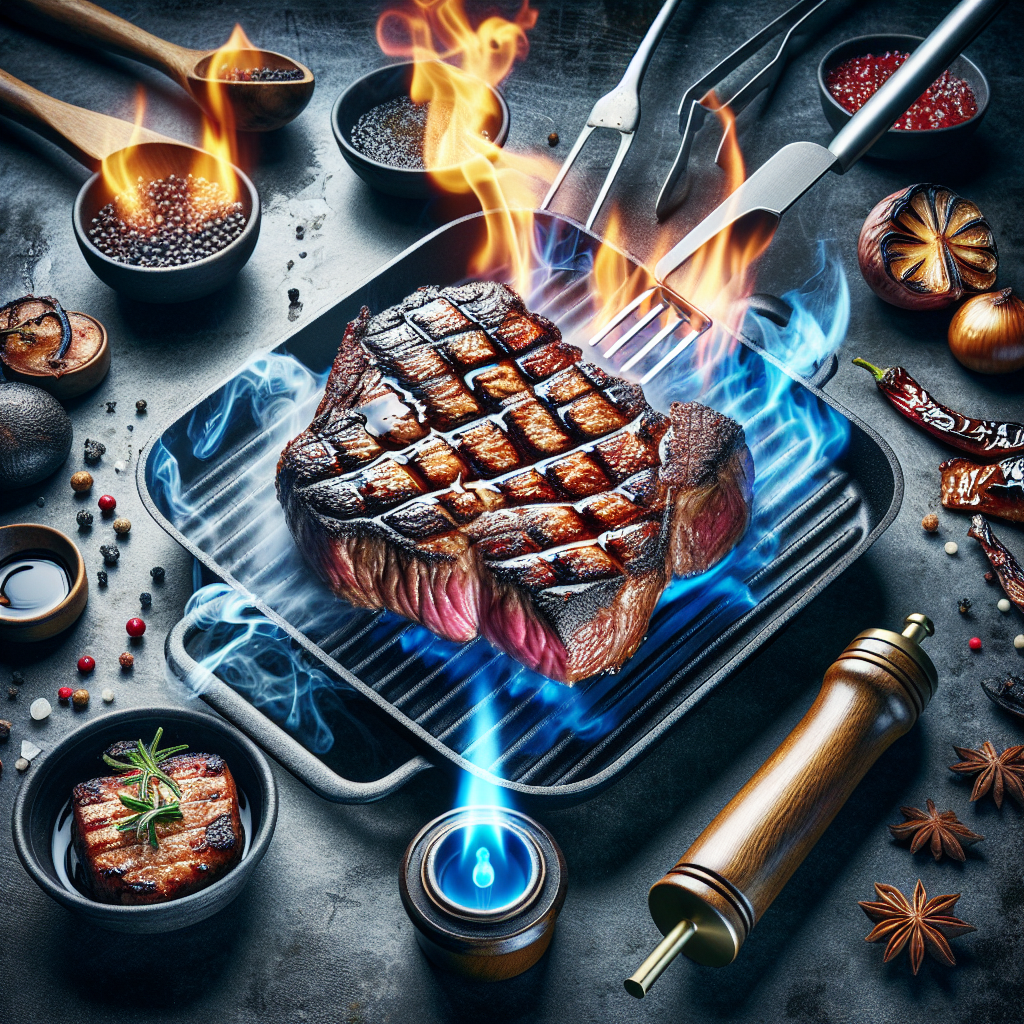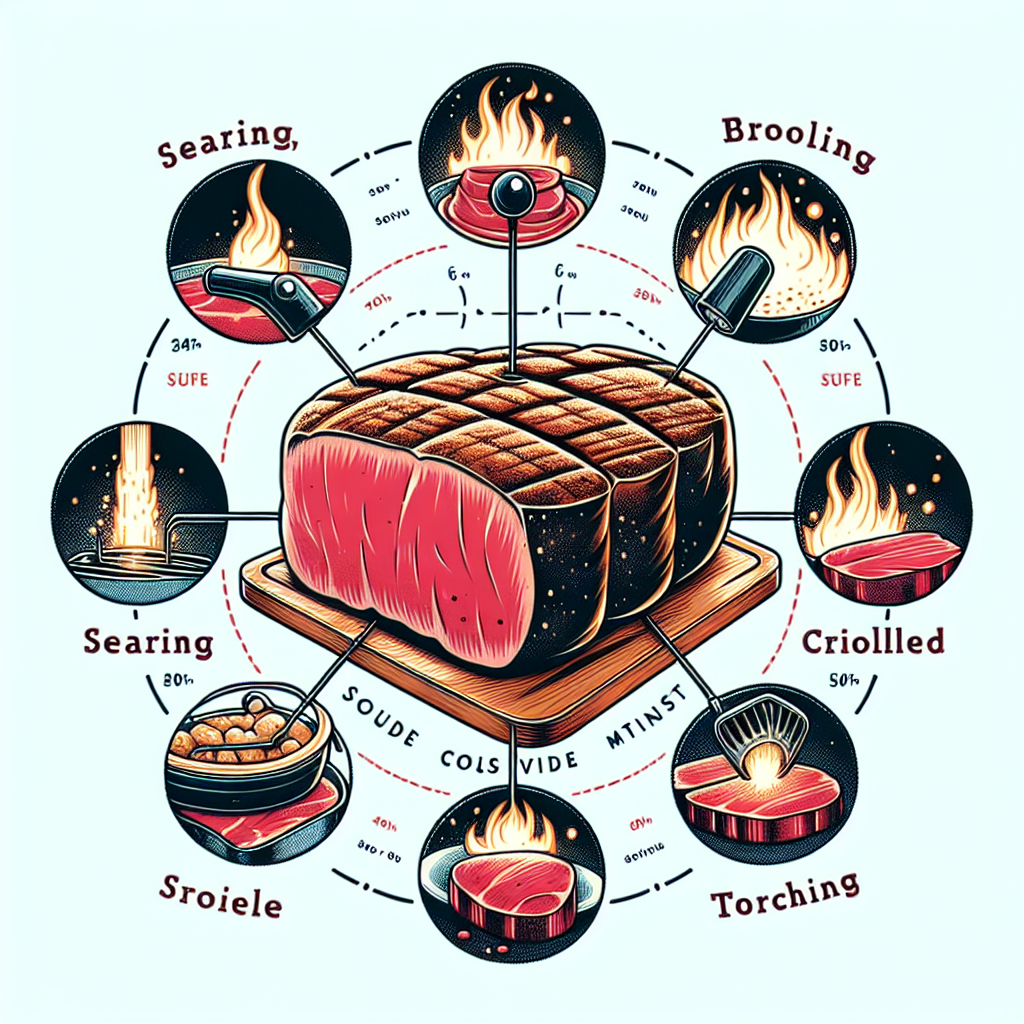
When it comes to perfecting your sous vide-cooked meat, finding the best way to finish it is key. With the sous vide technique providing consistently tender and flavorful results, it’s important to add that extra touch to elevate your dish to the next level. Whether it’s a quick sear on a hot grill or a sizzling hot pan, exploring the various finishing methods can make all the difference in creating a mouthwatering masterpiece. So, let’s explore the options and discover the most delectable way to finish your sous vide-cooked meat. Get ready to take your culinary skills to new heights!
The Importance of Finishing Sous Vide-Cooked Meat
Why is the finishing step necessary?
When cooking meat using the sous vide method, the finishing step is crucial to achieving optimal results. While sous vide cooking ensures precise temperature control and even cooking throughout the meat, it can result in a lack of flavorful crust on the exterior. The finishing step helps in developing a beautiful caramelized crust and enhancing the overall texture and taste of the meat.
What does finishing do to the meat?
Finishing sous vide-cooked meat adds the delightful Maillard reaction, which creates a delicious golden-brown crust. This reaction occurs when the proteins in the meat combine with sugars, resulting in complex flavors and aromas. Additionally, finishing techniques such as searing, grilling, or broiling can create a contrast in texture between the crispy exterior and the tender interior, elevating the overall eating experience.
Methods for Finishing Sous Vide-Cooked Meat
1. Searing
Searing is perhaps the most popular and widely-used method for finishing sous vide-cooked meat. It involves applying high heat to the meat’s surface, creating a flavorful crust and adding attractive grill marks. Whether using a hot skillet or a grill, searing enhances the caramelization process, resulting in a visually appealing and mouthwatering taste.
2. Grilling
Grilling is an excellent method for finishing sous vide-cooked meat, especially for thicker cuts like steaks or pork chops. The open flames and smoky flavors imparted by the grill enhance the overall taste and provide a charred exterior. By carefully monitoring the cooking time, you can achieve a perfect balance between a juicy interior and a charred, flavorful crust.
3. Broiling
Broiling is a convenient method for finishing sous vide-cooked meat, particularly for smaller cuts. It involves placing the meat directly under the broiler, subjecting it to intense, direct heat. The close proximity to the heating element quickly develops a delicious crust, making broiling an efficient choice for achieving that sought-after caramelized exterior.
4. Roasting
Roasting is ideal for finishing larger pieces of sous vide-cooked meat, such as whole chickens or roasts. By placing the meat in a hot oven, the dry heat promotes browning and develops savory flavors. The longer cooking time allows the meat to slowly reach the desired level of doneness while still obtaining a delectable crust.
5. Smoking
Smoking is an excellent option for adding a distinct and rich flavor to your sous vide-cooked meat. By using a smoker, you can impart the tantalizing taste of wood smoke while simultaneously finishing the meat. Whether using traditional wood chips or experimenting with unique flavors like apple or hickory, smoking can elevate the nuances of your dish to new heights.
6. Frying
Frying is a fantastic way to finish sous vide-cooked meat when seeking an incredibly crispy and crunchy exterior. By quickly frying the sous vide-cooked meat in hot oil, you can achieve unparalleled crispiness combined with tender and succulent meat. This method is particularly well-suited for breaded or battered cuts, such as chicken or pork schnitzel.
7. Braising
Braising is a method of finishing sous vide-cooked meat that involves slowly cooking it in a flavorful liquid. By simmering the meat in a braising liquid, such as a hearty broth or sauce, you infuse it with additional flavors while ensuring it remains moist and tender. This technique is commonly used for tougher cuts of meat, allowing them to become fork-tender and packed with rich flavors.
8. Torch Searing
Utilizing a culinary torch is an excellent finishing technique for smaller cuts or delicate proteins. The intense heat generated by the torch creates a caramelized crust quickly and precisely. This method allows for greater control over the level of browning and avoids overcooking or drying out the meat. It is a popular choice for finishing steak cuts like tenderloin or filet mignon.
9. Blanqueting
Blanqueting, also known as blanching, is a unique method for finishing sous vide-cooked meat. It involves briefly immersing the meat in boiling water or hot oil to quickly cook the exterior. This step is followed by a rapid chill in ice water to halt the cooking process. Blanqueting can be particularly useful for achieving a crisp exterior combined with a perfectly cooked interior.
10. Sous Vide Finishing
An intriguing method involves utilizing the sous vide technique for both the cooking and finishing stages. By temporarily raising the cooking temperature during the sous vide process, you can achieve the desired crust while maintaining the even and precise cooking associated with sous vide. This method is ideal for achieving a consistent result across the entire piece of meat.

Considering the Type of Meat
Best finishing method for beef
Beef is known for its rich and intense flavors, and the best finishing method for beef would be searing. The high heat of a skillet or grill helps develop the caramelized crust, enhancing the taste and texture of the beef. Additionally, grilling or smoking can also impart smoky flavors that pair exceptionally well with beef.
Best finishing method for chicken
For chicken, a combination of searing and roasting is a winning approach. Searing the chicken in a skillet or on a grill creates a flavorful crust, while roasting in the oven ensures even cooking and a juicy interior. If seeking a crispy skin, finishing the chicken under the broiler can also be a great option.
Best finishing method for pork
Pork benefits greatly from methods like searing and grilling. These techniques create a caramelized crust that pairs splendidly with the tender and succulent meat. If desired, smoking can add an extra layer of complexity to the flavor profile of the pork, making it an excellent choice for pork ribs or shoulder.
Best finishing method for fish
Fish is delicate, requiring careful handling during the finishing step. Searing is an excellent method for fish, providing a crisp exterior while maintaining the tender flakes of the meat. Grilling or broiling can also add a smoky or charred flavor, enhancing the overall taste and presentation. However, it is essential to be mindful of the cooking time to prevent overcooking the fish.
Best finishing method for lamb
Like beef, lamb benefits greatly from searing or grilling. These methods develop a savory crust that complements the natural flavors of the meat. Roasting can also be a suitable technique, allowing for gentle cooking and delicious caramelization. Consider finishing lamb with aromatic herbs and spices to enhance its taste further.
Flavoring and Seasoning Techniques
Marinating
Marinating is an excellent technique for adding flavor to sous vide-cooked meat. By immersing the meat in a marinade, you infuse it with a combination of herbs, spices, acids, and oils. The marinade not only imparts flavors but also tenderizes the meat, creating a succulent and well-seasoned result. Ensure adequate marinating time according to the type and thickness of the meat.
Dry Rubs
Dry rubs are perfect for adding a flavorful crust to sous vide-cooked meat. They consist of a mixture of herbs, spices, and seasonings applied directly to the meat’s surface. The dry rub enhances the taste and texture, developing a beautiful crust during the finishing process. Experiment with different combinations of ingredients to create your own signature dry rub.
Spices and Herbs
The use of spices and herbs can greatly enhance the flavor of sous vide-cooked meat during the finishing step. Whether incorporating aromatic herbs like rosemary or thyme, or spices like paprika or cumin, they add depth and complexity to the overall taste. Consider rubbing or sprinkling these seasonings on the meat before finishing to elevate its flavor.
Sauces and Glazes
Sauces and glazes provide a finishing touch to sous vide-cooked meat, adding moisture and intensifying the taste. From classic steak sauces to tangy BBQ glazes, there is a wide range of options to suit any preference. Applying the sauce or glaze during the final minutes of finishing ensures that it forms a delicious coating on the meat’s surface.

Temperature and Time Considerations
Matching finishing technique with appropriate temperature
Properly matching the finishing technique with the appropriate temperature is essential for achieving the desired results. For searing, grilling, or frying, high heat is recommended to quickly develop a flavorful crust. For roasting or smoking, moderate temperatures are preferable to ensure thorough cooking without prematurely charring the exterior. Carefully follow temperature guidelines for each finishing method to avoid overcooking or undercooking the meat.
Effects of finishing time on texture and flavor
The finishing time plays a crucial role in determining the texture and flavor of sous vide-cooked meat. Longer finishing times can result in a more pronounced caramelized crust, but may also lead to a drier interior. Conversely, shorter finishing times can yield a juicier and more tender interior but may not develop as strong of a crust. Finding the perfect balance between texture and flavor requires experimentation and careful monitoring of the cooking process.
Tips and Tricks for Perfectly Finished Sous Vide-Cooked Meat
Resting the meat before finishing
Resting the sous vide-cooked meat for a few minutes before finishing allows the juices to redistribute, ensuring a moist and flavorful result. This resting period also helps the meat retain its moisture during the high heat of the finishing step. By implementing this simple technique, you can achieve a more even and succulent piece of meat.
Preheating the finishing surface
When using methods like searing, broiling, or grilling, preheating the cooking surface is essential for achieving a proper crust. By ensuring the skillet, grill grates, or broiler is adequately preheated, you create an environment that encourages caramelization and prevents the meat from sticking. This step helps to develop a delicious and visually appealing crust.
Utilizing flavored oils or butter for searing
Enhance the flavor and richness of the crust by utilizing flavored oils or butter during the searing process. These can be infused with herbs, garlic, or spices to impart additional taste to the meat. Adding a small knob of butter to the pan when searing can provide a decadent and luscious finish to the sous vide-cooked meat.
Adding finishing touches with a blowtorch
To achieve a perfectly charred and caramelized crust, consider using a culinary blowtorch as a finishing touch. This tool allows for precise browning and charring, giving you complete control over the level of doneness and enhancing the visual appeal of the dish. Utilize the blowtorch to put the final touches on your sous vide-cooked meat, creating a restaurant-quality finish in the comfort of your own kitchen.
Common Mistakes to Avoid
Overcooking the meat during finishing
One of the most common mistakes when finishing sous vide-cooked meat is overcooking it. It’s crucial to be mindful of the high heat applied during the finishing step to prevent drying out or overcooking the meat. Monitoring the temperature and cooking time is vital to achieve the desired level of doneness without sacrificing texture or flavor.
Underseasoning or neglecting flavoring techniques
Neglecting to season the meat adequately or skipping flavoring techniques can result in a bland finished product. Take advantage of marinating, using dry rubs, or adding spices and herbs to elevate the taste. Experimenting with different flavor profiles allows you to customize your sous vide-cooked meat to suit your preferences.
Neglecting temperature and time considerations
Failing to match the appropriate finishing technique with the correct temperature can lead to inconsistent results. Similarly, not considering the effects of finishing time on texture and flavor may result in overcooked or underdeveloped crust. Take the time to understand temperature and time guidelines for different methods to ensure superbly finished sous vide-cooked meat.
Not properly resting the meat before finishing
Skipping the resting period before finishing can lead to dry and unevenly cooked meat. Allowing the meat to rest for a few minutes allows the juices to redistribute, resulting in a more succulent and flavorful end product. Don’t rush the process and give the meat the time it needs to fully develop its potential.
In conclusion, finishing sous vide-cooked meat is a crucial step in achieving delicious and visually appealing results. Whether searing, grilling, roasting, or utilizing alternative methods, the finishing step adds that sought-after caramelized crust and enhances the overall taste and texture of the meat. By considering the type of meat, employing flavoring techniques, and taking into account temperature and time considerations, you can create perfectly finished sous vide-cooked meat that will impress your family and friends. Remember to also avoid common mistakes such as overcooking or neglecting flavoring techniques, and be sure to rest the meat before finishing for the best possible outcome. With these tips and tricks, you’ll be well on your way to becoming a master of finishing sous vide-cooked meat. Happy cooking!





